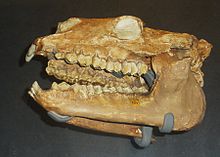Diadiaphorus
| Diadiaphorus | |
|---|---|

| |
| Diadiaphorus robustus skull | |
| Scientific classification | |
| Kingdom: | Animalia |
| Phylum: | Chordata |
| Class: | Mammalia |
| Order: | †Litopterna |
| Family: | †Proterotheriidae |
| Subfamily: | † |
| Genus: | †Diadiaphorus Ameghino, 1887 |
| Species | |
|
† D. caniadensis | |
| Synonyms | |
| |
Diadiaphorus is an extinct genus of litoptern mammal from the Miocene of Argentina (Ituzaingó, , and ) and Bolivia (), South America.
Description[]

Diadiaphorus closely resembled a horse, but was only around 1.2 metres (3.9 ft) in body length with a weight 70 kilograms (150 lb), similar to a modern sheep.[1] It had three toes, only one of which touched the ground. This toe had a large hoof; the two outer toes were rudimentary, much like those of early horses such as Merychippus. Unlike horses, however, Diadiaphorus lacked fused limb bones. Its skull was short and had a relatively large brain cavity. Judging from its low molars, Diadiaphorus ate soft vegetation, such as leaves.[2]
References[]
- Litopterns
- Miocene mammals of South America
- Huayquerian
- Chasicoan
- Mayoan
- Laventan
- Colloncuran
- Friasian
- Santacrucian
- Neogene Argentina
- Fossils of Argentina
- Ituzaingó Formation
- Neogene Bolivia
- Fossils of Bolivia
- Fossil taxa described in 1887
- Taxa named by Florentino Ameghino
- Prehistoric placental genera
- Prehistoric mammal stubs








